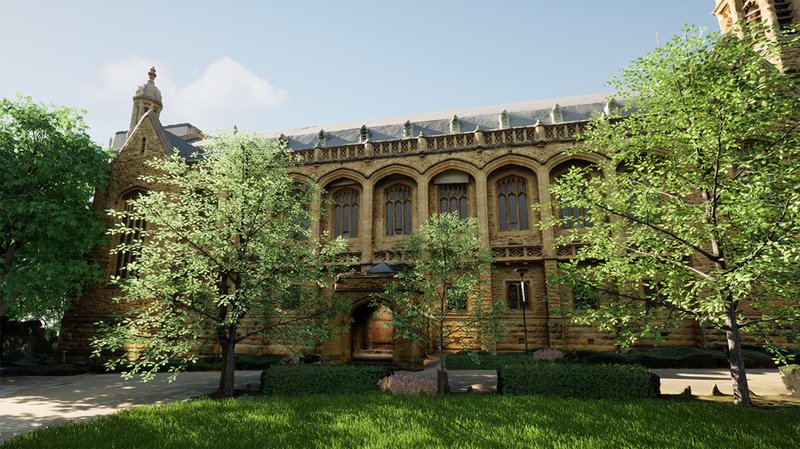Virtual tourism is an ideal proxy for travel during this period of restricted movement. Ongoing, virtual tourism will play a marketing role to draw tourists into real-world locations. In future, virtual tourism assets remain valuable for their historical archiving of places.
Spatial experts and world leaders in 3D modeling Aerometrex have years of experience in recreating spaces for virtual tourism. The pandemic world is causing a rapid maturing of virtual tourism, and Aerometrex sees significant growth in the experiences created with their spatial data.
In its simplest form, virtual tourism is the recreation of a location or experience intended to either substitute for an actual visit or inspire one in future. Virtual tourism has existed in a basic form for decades: magazine spreads full of beautiful photos or television shows presenting aspirational experiences have created emotive situations to draw travellers.
Modern virtual tourism uses the apex of content production and delivery. From virtual reality, 360° videos, to web-browser based interactive experiences, viewers can easily access and engage with digital content. Similarly, Aerometrex’s 3D modelling production capabilities improve alongside the digital delivery platforms to make ever-more accurate renditions.

Our 2021 Melbourne model visualized in Unreal Engine 5
Aerometrex’s massive multiscale 3D models are ideal for virtual tourism. Real-world locations are photographed from aerial platforms, including aeroplanes, and helicopters. Aerial capture methods can give outstanding detail levels, to which Aerometrex’s additional street-level photography fills in fine features. From thousands of 2D images, a life-like and life-size 3D model gets built using photogrammetry techniques.
3D mesh models are a compelling asset because their size and detail let them work from any elevation or proximity. Viewers can experience elevated flyovers before dropping to the ground for photo-realistic vistas. Improving camera and sensor hardware matched with software and processing techniques mean future 3D assets will only get better.
Aerometrex’s work in building virtual worlds for tourism began well before the COVID-19 pandemic, recreating individual buildings and properties to long stretches of coastlines and substantial sections of cities over the last decade.
Below are some examples of Aerometrex’s tourism-oriented 3D modeling.
2020 saw Aerometrex’s first model commissioned entirely for virtual tourism. Aerometrex recreated the City of Adelaide’s North Terrace and Seppeltsfield Winery in the neighbouring Barossa Valley in 3D.
The model showcases the Adelaide Convention Centre and Seppeltsfield Winery to draw lucrative corporate events, conventions, and the thousands of associated attendees to the city. Tying professional events and boutique tourism experiences primes the end user to spend more money in the local economy. Seppeltsfield Winery’s digital twin historically archives the site and has uses for advanced 3D visualisation-based marketing.

The Adelaide University's Bonython Hall from our North Terrace capture
France’s “City of Art and History”, Pau in the Pyrenees, commissioned Aerometrex to build a 3D model of their old city in 2019. The final Pau model used over 100,000 2D images with resolution between 3mm and 20mm per pixel to build the mesh.
Project Manager Jean-Michel Lopez said “In tourism, the model can be a real ambassador for the city. People can walk like a pedestrian in a virtual space. This tool can be enriched with references from merchants, companies or services, so that the viewer can click on a front door or storefront and switch either to their website or to the digital model of the interior of the building.”
Tourism was only a single use for Pau’s model. The city uses it for town planning, transportation and traffic management, heritage documentation of the old city, risk management, and urban logistics.

The streets of Pau in visualized in Twinmotion
Aerometrex captured 80 km2 of Victoria’s Great Ocean Road for the Department of Environment, Land, Water, and Planning as part of the ongoing Great Ocean Road Action Plan.
The result is a model giving anyone the ability to be transported to the 12 Apostles, the Gibson Steps or Loch Ard Gorge, to name a few sites. A virtual flight along the coastline is now a reality for anyone with access to a computer.
Coastal erosion makes the data capture more important because the landscape is forever changing. The model enables more people than ever to experience the incredible views during a time of restricted travel.
The digital twins of today’s cities will be base assets for virtual tourism in the future.
Future visualisation platforms with AI-based systems to increase resolution, enhance textures, and fill in any gaps in current models will ensure the longevity of current 3D data. That will make immersive, time-based virtual tourism, educational experiences, and city-wide spatial data archiving completely viable.
Aerometrex’s 3D models of regions such as Pau, Bendigo, the Great Ocean Road, and Denver will be usable far into the future for anyone wanting to experience specific snapshots in time. The core data of Aerometrex’s 3D modeling will act as useful assets for virtual tourism and many other spatial industries long into the future.